
Leila Chaoui
An expert in natural beauty remedies, our author brings a wealth of knowledge and passion for Moroccan Argan Oil, guiding readers on its benefits and versatile uses for radiant skin and hair.
Key Takeaways
You may be wondering why harvesting argan for organic oil production is worth the effort. Well, let me tell you, the benefits are truly remarkable. Not only does argan oil possess numerous health and beauty benefits, but the process of harvesting and producing this oil is deeply rooted in sustainability and eco-friendly practices. From the traditional methods of handpicking the argan nuts to the careful extraction of the valuable kernels, every step is meticulously executed to ensure the authenticity and purity of the oil. But that’s not all; there’s an intriguing role that women play in this process, and a unique method used for oil extraction that you won’t want to miss.
- Argan trees provide a sustainable resource for organic oil production in Morocco and Algeria.
- Women in local cooperatives play a significant role in handpicking ripe argan fruits for harvesting.
- Handpicking ensures selection of high-quality, ripe fruits ideal for oil production.
- Sustainable practices, fair labor conditions, and biodiversity conservation are prioritized for argan oil production.
Argan Tree: A Sustainable Resource
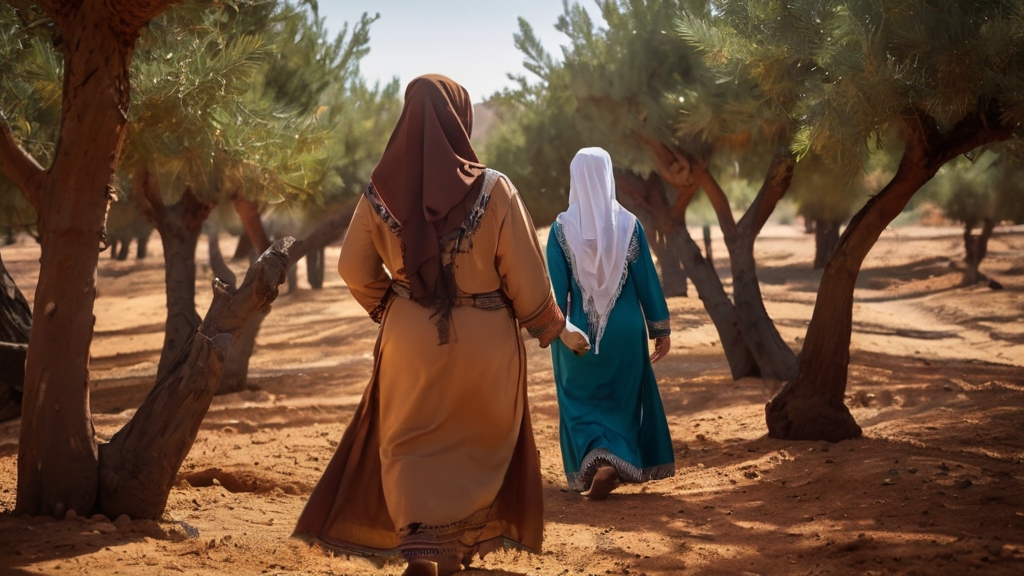
The argan tree serves as a sustainable and invaluable resource for the production of organic oil due to its endemic presence in Morocco and Algeria. This tree plays a crucial role in providing a sustainable resource for organic oil production. It is particularly significant for the local economy and culture, with women often involved in the harvesting process. The argan tree’s ability to thrive in arid climates makes it a resilient and valuable resource for organic oil production.
The argan tree produces small yellow-green fruits with oil-rich kernels, which are essential for extracting high-quality organic oil. These kernels are carefully harvested and processed to obtain the precious oil. Sustainable harvesting practices ensure the preservation of the argan tree as a significant and renewable source for organic oil production.
One of the reasons why the argan tree is considered a sustainable resource is its ability to withstand harsh conditions. It has adapted to thrive in arid climates, where it can survive with minimal water and nutrients. This resilience makes it an ideal candidate for organic oil production, as it doesn’t require excessive resources or extensive irrigation systems.
The argan tree’s significance in the local culture is reflected in the involvement of women in the harvesting process. Women play a vital role in collecting the fruit and extracting the oil-rich kernels. This involvement not only empowers women economically but also contributes to the preservation of traditional practices and knowledge.
Traditional Harvesting Techniques
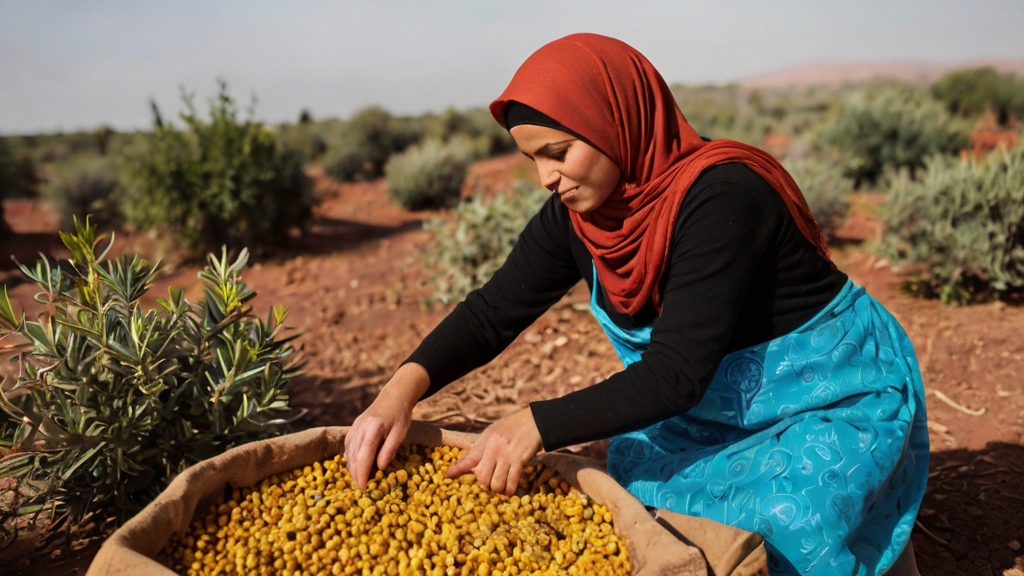
Using traditional methods, the ripe fruits of the argan tree in Morocco are carefully hand-picked for their high-quality oil extraction. This centuries-old practice involves a meticulous process that ensures the preservation of the argan tree population and the production of sustainable and authentic organic argan oil. Here are the key aspects of traditional argan harvesting techniques:
- Women’s Involvement: Women in local cooperatives play a significant role in the traditional argan harvesting process. They are responsible for selecting and collecting the ripe argan fruits, showcasing their expertise in identifying the fruits that are ready for oil extraction. This involvement empowers women economically and socially, contributing to their livelihoods and the preservation of traditional practices.
- Sustainable Practices: Traditional argan harvesting techniques prioritize sustainability. The hand-picking method allows for selective harvesting, ensuring that only ripe fruits are collected. By avoiding mechanical harvesting methods, the argan tree population is protected from damage, and the ecosystem is preserved. This sustainable approach promotes the long-term viability of the argan tree and its valuable resources.
- Quality Assurance: Traditional harvesting techniques are essential for maintaining the high quality of argan oil. Hand-picking ensures that only the best fruits are selected, free from damage or premature ripening. This attention to detail guarantees that the resulting oil is of premium quality, with its distinct nutty aroma and rich, golden color.
- Seasonal Timing: Harvesting the argan fruits is typically done during the summer months when they are fully ripe and ready for processing. This timing ensures optimal oil extraction and helps maintain the natural properties of the fruits. It also aligns with the traditional knowledge passed down through generations, ensuring the authenticity and effectiveness of the argan oil production process.
Importance of Handpicking Argan Nuts
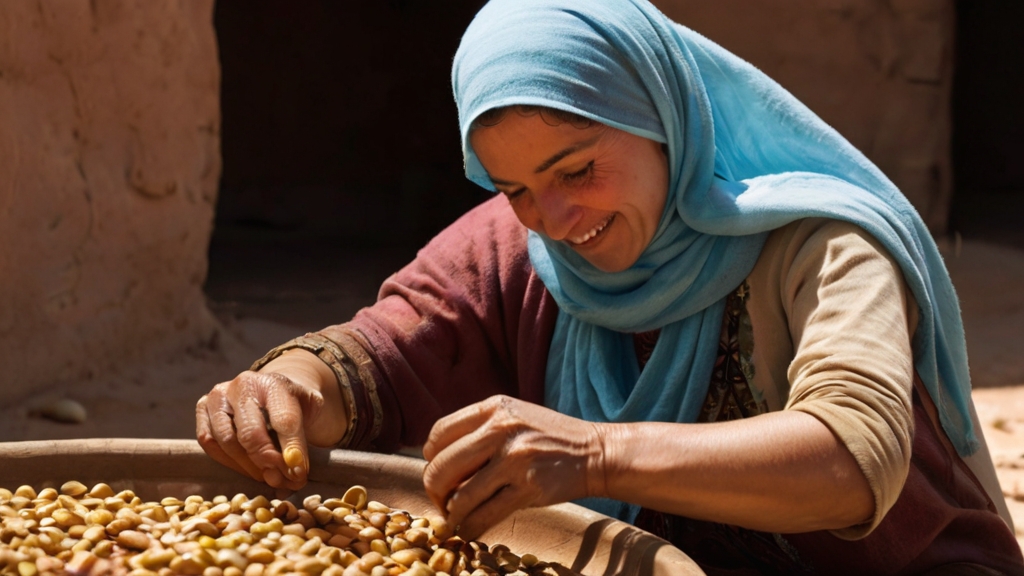
When it comes to the importance of handpicking argan nuts, several key points need to be considered. Firstly, handpicking ensures the selection of high-quality, ripe fruits that are ideal for oil production. This traditional method allows for careful examination of each nut’s quality, resulting in superior quality oil that is rich in nutrients and antioxidants. Moreover, handpicking not only contributes to the authenticity and premium nature of organic argan oil but also supports sustainable practices and fair labor in the argan oil industry.
Handpicking for Quality
Handpicking argan nuts by skilled workers in women’s cooperatives ensures the selection of high-quality fruits for superior argan oil production. This meticulous process of handpicking allows for the exclusion of damaged or unripe nuts, ensuring only the best quality nuts are used for oil extraction. By handpicking the ripe argan nuts, the women’s cooperatives promote sustainability by preserving the best nuts for extraction, thus minimizing waste. Quality control starts with handpicking, as it guarantees the excellence of the final organic argan oil product. The attention to detail and expertise of the workers in these cooperatives play a crucial role in maintaining the high standards required for argan oil production.
- Handpicking allows for the exclusion of damaged or unripe nuts
- Skilled workers in women’s cooperatives meticulously handpick ripe argan nuts
- Handpicking promotes sustainability by preserving the best nuts for extraction
- Quality control starts with handpicking, ensuring the excellence of the final organic argan oil product.
Sustainable Harvesting Methods
To ensure the highest quality and promote sustainable harvesting practices, the handpicking of Argan nuts by skilled workers in women’s cooperatives plays a crucial role in the production of superior argan oil. This method not only supports fair labor practices and empowers local women but also contributes to environmental preservation. Handpicking allows for selective harvesting of ripe fruits, which leads to higher-quality oil extraction. By carefully selecting only the ripest nuts, the handpickers ensure that the oil produced is of the highest quality. This sustainable harvesting method also helps prevent damage to the Argan trees, preserving the delicate ecosystem they inhabit. Furthermore, the cultural significance of the Argan tree is upheld through the involvement of local women in the production process. The table below highlights the importance of handpicking in sustainable harvesting methods:
| Benefits of Handpicking Argan Nuts |
|---|
| Supports fair labor practices |
| Empowers local women |
| Ensures higher-quality oil extraction |
| Contributes to environmental preservation |
The Role of Women in Argan Harvesting
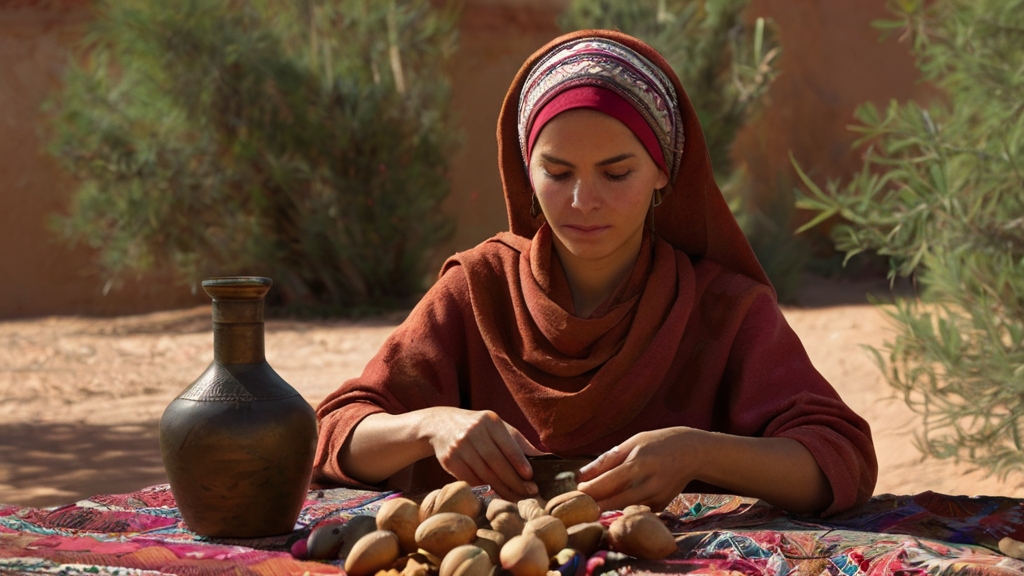
Women in local cooperatives play a vital role in ensuring the purity and quality of organic Argan oil through their meticulous hand-cracking and grinding of selected high-quality Argan nuts. Their expertise and dedication contribute significantly to the labor-intensive process of Argan harvesting and oil production. Here are four reasons why the role of women in Argan harvesting is crucial:
- Selection of High-Quality Argan Nuts: Women in cooperatives have a deep understanding of Argan nuts and can identify the best ones for oil production. They carefully handpick the nuts, ensuring that only the finest quality nuts are used in the process.
- Meticulous Hand-Cracking: Women are traditionally responsible for the labor-intensive task of hand-cracking the Argan nuts to extract the kernels. Their meticulous technique ensures that the kernels remain intact and undamaged, preserving the oil’s purity and quality.
- Manual Grinding: After hand-cracking the nuts, women manually grind the kernels to prepare them for the pressing and filtering stages. This manual grinding process helps maintain the natural properties of the Argan oil and ensures its high quality.
- Community Empowerment and Local Economy: The involvement of women in Argan harvesting and oil production has brought about significant community empowerment and economic benefits. By working in cooperatives, women have gained financial independence and improved their social status. Additionally, the income generated from Argan oil production contributes to the local economy, supporting the development of the community.
The role of women in Argan harvesting is essential for the production of organic Argan oil. Their meticulous hand-cracking and grinding techniques, along with their contribution to community empowerment and the local economy, ensure the purity and quality of the oil. By supporting women cooperatives and the labor-intensive process of Argan harvesting, we can continue to enjoy the benefits of this precious oil while serving the needs of the community.
Drying and Cracking the Argan Nuts
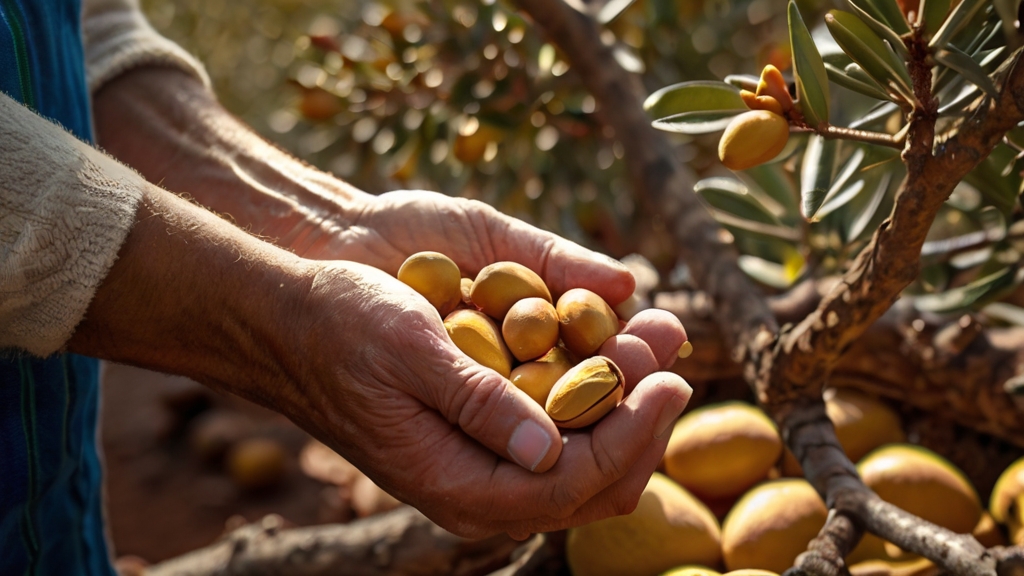
To begin the discussion on drying and cracking the Argan nuts, it is important to understand the different methods of nut drying. The traditional method involves placing the nuts in the sun for several weeks, allowing the natural heat and air to dry them out. This process not only aids in the cracking process but also helps to preserve the quality of the kernels inside. Once the nuts are dried, they are carefully cracked by hand using stones, a labor-intensive technique that requires precision to extract the valuable kernels without damaging them.
Nut Drying Methods
Drying and cracking the Argan nuts is a crucial step in the production of argan oil, as it allows for the extraction of the valuable kernels inside. Proper drying methods are essential to ensure the quality of the extracted oil. Here are some important facts about nut drying methods:
- Drying argan nuts can take up to several weeks under the sun to reduce moisture content.
- Traditional methods involve air-drying the nuts to preserve their natural properties.
- Nuts are cracked after drying to access the kernels inside for oil extraction.
- Proper drying prevents mold growth and ensures the quality of the extracted oil.
Controlling the drying conditions is of utmost importance to maintain the integrity of the argan kernels and guarantee the highest quality of the final product. By carefully drying and cracking the nuts, the valuable kernels are prepared for the next step in the production process.
Cracking Techniques
After properly drying the Argan nuts to reduce moisture content, the next step in the production process involves cracking the nuts to access the valuable oil-rich kernels inside. Traditional methods of cracking involve hand-cracking the nuts using stones, while modern techniques may employ mechanical cracking. However, regardless of the method used, it is crucial to ensure proper drying of the nuts to make them brittle and facilitate efficient cracking without damaging the kernels. The cracking process plays a significant role in the quality preservation of the oil-rich kernels, which directly impacts the final yield and quality of the Argan oil. By employing careful cracking techniques, producers can maximize the extraction of the oil-rich kernels and optimize the overall production process.
Importance of Thoroughness
Thoroughness in the drying and cracking process of Argan nuts is essential for preserving the natural properties and maximizing the extraction of oil-rich kernels, ultimately ensuring the production of high-quality Argan oil. Here are four reasons why this step is crucial in organic oil production:
- Drying the Argan nuts properly prevents mold growth and prepares the kernels for extraction.
- Proper drying techniques enhance the flavor and quality of the resulting Argan oil, providing a delightful taste experience.
- Cracking the Argan nuts by hand requires skill and precision to extract the kernels intact, ensuring a higher oil yield.
- Thoroughness in drying and cracking the Argan nuts is fundamental to preserving the natural properties and benefits of the oil, resulting in a pure and organic product.
Extracting the Valuable Argan Kernels
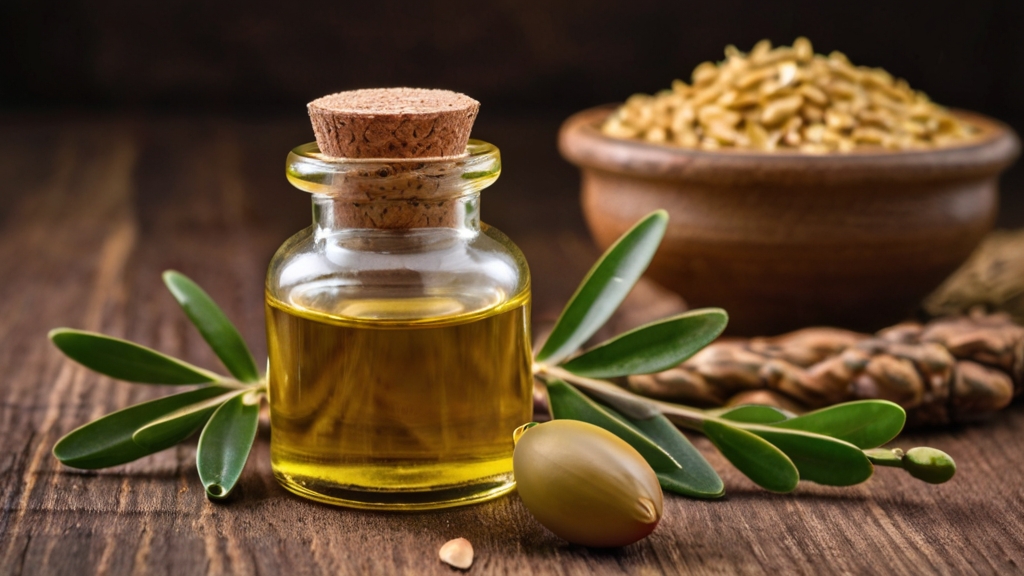
To extract the valuable Argan kernels, a meticulous process is employed that involves drying, cracking, and separating them from the fruit pulp of the Argan tree. This extraction method is crucial in obtaining the highly sought-after Argan oil, which is widely used in cosmetic products.
The process begins with the collection of the ripe Argan fruit, which is then left to dry in the sun. This drying process helps to remove the moisture content and facilitates the separation of the kernels from the pulp. Once dried, the fruit is cracked open to reveal the Argania Spinosa kernels nestled inside.
The cracked kernels are carefully separated from the fruit pulp using traditional methods. This artisanal process ensures that the kernels remain intact and undamaged, preserving the quality of the oil they contain. The separated kernels are then ground or pressed to extract the precious oil.
Argan oil extraction is a labor-intensive process, often requiring manual labor. The traditional oil extraction methods have been passed down through generations, highlighting the cultural significance of Argan oil production. These methods have been refined over time to maximize the oil yield and maintain its quality.
The value of Argan oil lies in its high content of unsaturated fatty acids, which contribute to its moisturizing and nourishing properties. These fatty acids, such as linoleic acid and oleic acid, provide numerous benefits for the skin and hair, making Argan oil a popular ingredient in skincare and haircare products.
Cold-Pressing Method for Oil Extraction
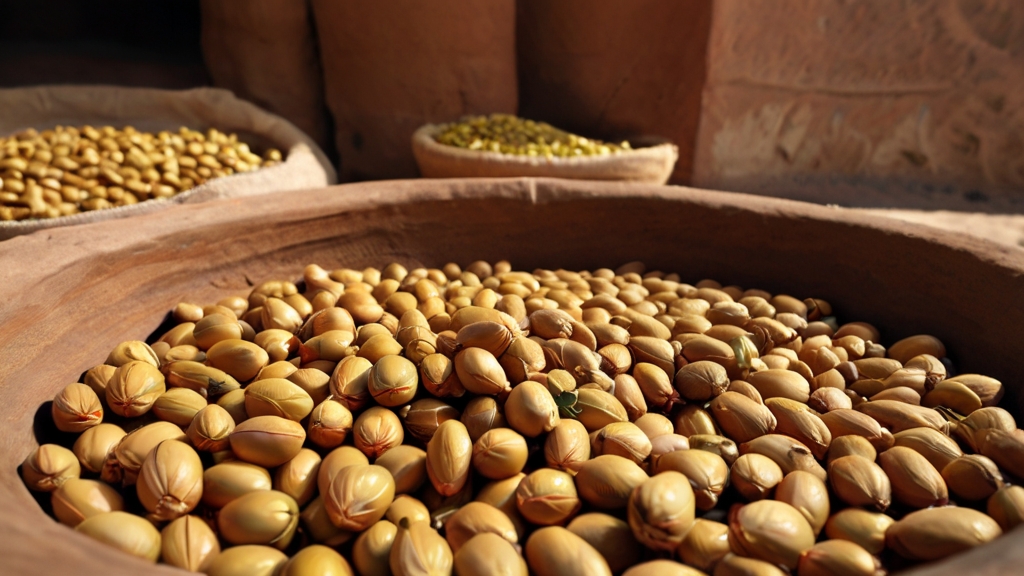
To preserve the nutrients and natural properties of Argan oil, the cold-pressing method is employed for oil extraction. This method ensures minimal heat is used during the extraction process, allowing the oil to retain its valuable nutrients and benefits. Here are some key points about the cold-pressing method for argan oil extraction:
- Nutrients Preservation: The cold-pressing method involves using mechanical pressure to extract the oil from the argan kernels, without the use of excessive heat. This helps preserve the delicate nutrients present in the oil, ensuring its purity and effectiveness.
- Antioxidants: Cold-pressed argan oil is rich in antioxidants, which help protect the skin from free radicals and environmental damage. These antioxidants help reduce signs of aging and promote a healthy, youthful complexion.
- Essential Fatty Acids: Argan oil extracted through the cold-pressing method is also abundant in essential fatty acids, such as omega-6 and omega-9. These fatty acids nourish and moisturize the skin, promoting hydration and improving its overall texture.
- Vitamin E: Cold-pressed argan oil is a natural source of vitamin E, a powerful antioxidant that helps repair and protect the skin. Vitamin E also aids in reducing inflammation and promoting healing, making it beneficial for various skin concerns.
Cold-pressed argan oil is highly regarded for its purity and effectiveness in skincare and haircare. The gentle extraction method ensures that the oil retains its natural properties, allowing it to provide maximum benefits for your skin and hair. Whether you are looking to moisturize, nourish, or rejuvenate, cold-pressed argan oil is a versatile and valuable addition to your beauty routine.
Organic Certification and Sustainable Practices
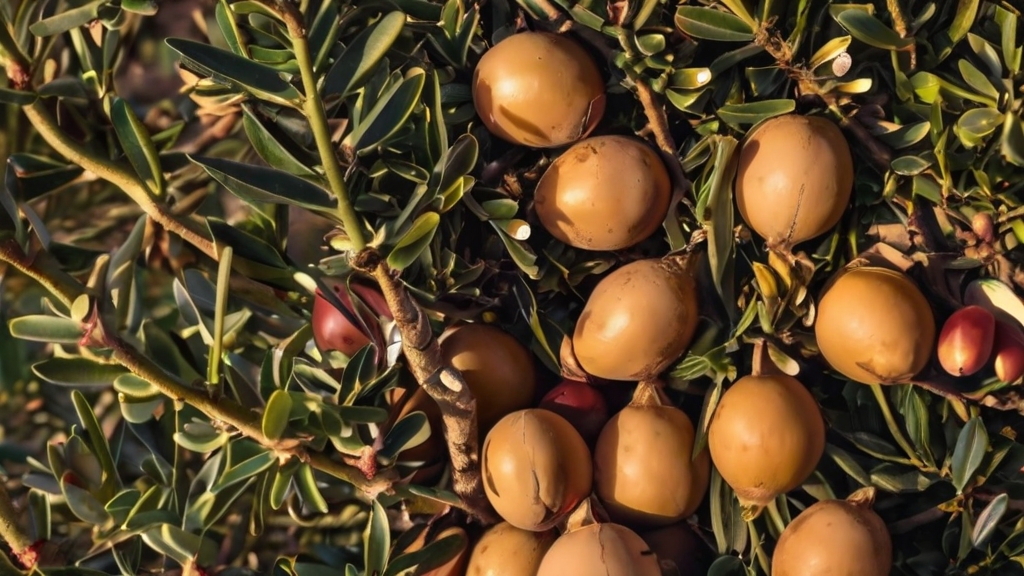
Organic certification and sustainable practices play a vital role in ensuring the quality, integrity, and environmental responsibility of Argan oil production. The organic certification for Argan oil guarantees compliance with strict agricultural standards, ensuring that the oil is produced in a manner that promotes environmental conservation and community well-being.
To obtain organic certification, Argan oil producers must adhere to specific guidelines. The cultivation of Argan trees must involve no synthetic pesticides or fertilizers, ensuring that the oil is free from harmful chemicals. This commitment to organic farming not only benefits the consumers who use the oil but also supports the long-term health of the ecosystem.
Sustainable practices in Argan oil production encompass various aspects. Water conservation is critical, as water scarcity is a pressing issue in the region where Argan trees grow. Producers implement techniques such as drip irrigation and rainwater harvesting to minimize water usage. Soil protection is also prioritized, with measures in place to prevent erosion and maintain soil fertility.
Furthermore, sustainable practices in Argan oil production emphasize fair labor conditions. Workers involved in the harvesting and processing of Argan nuts are treated with respect and provided with fair wages. This ensures that the community’s well-being is prioritized, creating a positive impact on the local economy.
Organic certification and sustainable practices also contribute to biodiversity conservation. The cultivation of Argan trees supports the growth of a diverse range of plant and animal species. By avoiding the use of synthetic chemicals and protecting the natural habitat, Argan oil production helps to maintain the delicate balance of the ecosystem.
Frequently Asked Questions
How Do You Harvest Argan Oil?
To harvest argan oil, you crack open the argan fruit shells to access the oil-rich kernels. Traditional methods involve hand-cracking, a labor-intensive process. Afterward, the kernels are ground and pressed to produce pure argan oil. This organic oil has numerous benefits, such as promoting healthy hair and skincare. Argan tree cultivation and sustainable practices support local communities and protect the environment. So, by harvesting argan oil, you not only serve others but also contribute to a greener world.
What Is the Purest Form of Argan Oil?
The purest form of argan oil is obtained through cold-pressed extraction methods, ensuring the preservation of its natural properties. You can identify pure argan oil by its nutty aroma and golden color. Some popular brands known for their pure argan oil products include Josie Maran, Pura D’or, and Majestic Pure. Pure argan oil is highly sought after due to its numerous benefits for the skin, hair, and nails. Its purity sets it apart from diluted versions and synthetic alternatives. The market demand for pure argan oil continues to grow as more people discover its amazing properties.
Why Is Argan Oil Only in Morocco?
Why is argan oil only in Morocco? The unique climate and soil conditions in Morocco create the perfect environment for argan trees to thrive. This, coupled with the traditional knowledge and techniques passed down through generations, has made Morocco the exclusive producer of argan oil. The cultural significance and economic impact of argan oil in Moroccan society cannot be understated. It is not just a skincare remedy, but also a culinary tradition and potential haircare solution. Argan oil production plays a vital role in sustaining local communities and preserving the ecosystem.
Where Does Organic Argan Oil Come From?
Organic Argan oil comes from the kernels of the Argan tree fruit, which is endemic to Morocco. It is extracted using traditional methods, often by women in local cooperatives. The oil is highly sought after due to its high quality and purity. It is used in skincare and hair products due to its numerous benefits. Sustainable harvesting practices are crucial for maintaining the integrity of organic Argan oil production. When buying organic Argan oil, look for authentic certification to ensure its quality and support the local communities.
Related Articles
Argan Oil Production From Argania Spinosa
Kept under lock and key, the secrets of argan oil production from Argania spinosa reveal the hidden treasures of this legendary liquid gold.
Health Benefits of Pure Argan Oil
Jumpstart your health and discover the surprising benefits of pure argan oil, from glowing skin to potential cancer-fighting properties.
Fatty Acid Content in Culinary Argan Oil
Discover the fascinating and varied fatty acid profile of culinary argan oil, and how it can elevate your dishes with its unique flavor and health benefits.


